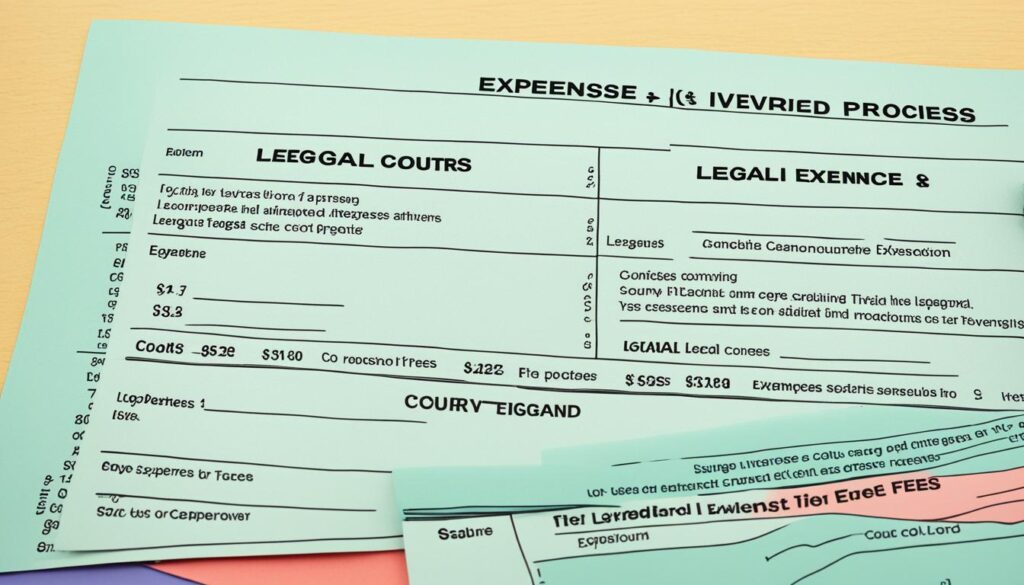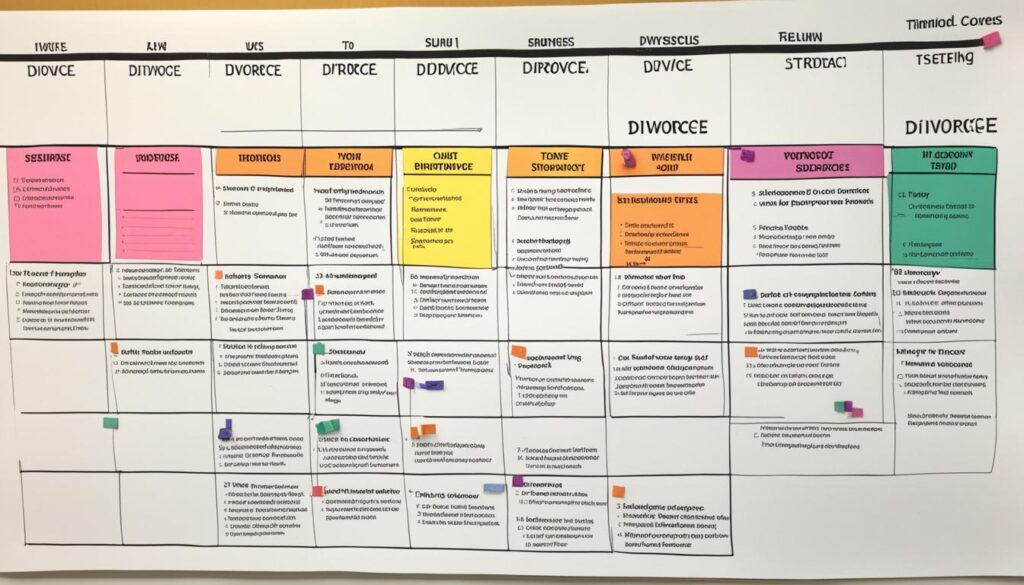Are you thinking about getting a divorce in Trinidad and Tobago? It is essential to understand the process of divorce to ensure a seamless and successful separation. In Trinidad and Tobago, a divorce is approved by the court after one party to the marriage, known as the petitioner, files a petition declaring the marriage to be over.
To obtain a divorce in Trinidad and Tobago, the petitioner or respondent must have been habitually resident in Trinidad and Tobago or domiciled in Trinidad and Tobago when the divorce proceedings began. The grounds for divorce in Trinidad and Tobago are based on the irretrievable breakdown of the marriage and include adultery, unreasonable behavior, desertion, separation with consent, and separation for a period of five years.
After the court grants a decree nisi, there is a waiting period before applying for a decree absolute, which finalizes the divorce. Custody, support, and property issues are also addressed during the divorce process.
Key Takeaways:
- The divorce process in Trinidad and Tobago requires a petition by one party to the marriage, known as the petitioner.
- One must be habitually resident or domiciled in Trinidad and Tobago to file for divorce in the country.
- Grounds for divorce in Trinidad and Tobago include adultery, unreasonable behavior, desertion, separation with consent, and separation for a period of five years.
- After the court grants a decree nisi, there is a waiting period before applying for a decree absolute.
- Custody, support, and property issues are addressed during the divorce process in Trinidad and Tobago.
Jurisdiction and Requirements for Divorce in Trinidad and Tobago
When it comes to getting a divorce in Trinidad and Tobago, it is important to understand the jurisdiction and requirements involved. To file for divorce in Trinidad and Tobago, at least one of the spouses must have been habitually resident or domiciled in Trinidad and Tobago when the divorce proceedings began.
The court in Trinidad and Tobago has jurisdiction over divorce cases even if the couple was not married in Trinidad and Tobago. This means that couples who were married outside of Trinidad and Tobago can still seek a divorce within the country.
When filing for divorce, certain requirements must be met. The first step is to file a petition, which includes providing important supporting documents such as a copy of the marriage certificate. Additionally, details of any other court cases related to the marriage, children, or property should also be included.
If the divorce involves children under the age of 16 or still attending school, a Statement of Arrangements for the children must also be prepared. This statement outlines the proposed arrangements for child custody, visitation, and support.
Understanding the jurisdiction and requirements for divorce in Trinidad and Tobago is crucial for a smooth divorce process. By following the necessary steps and providing the required documentation, individuals can navigate the divorce process more effectively.
| Requirements for Divorce in Trinidad and Tobago | Jurisdiction for Divorce |
|---|---|
| Filing a petition | At least one spouse must have been habitually resident or domiciled in Trinidad and Tobago |
| Providing supporting documents | The court has jurisdiction even if not married in Trinidad and Tobago |
| Copy of the marriage certificate | |
| Details of any other court cases related to the marriage, children, or property | |
| Statement of Arrangements for children (if applicable) |
Grounds for Divorce in Trinidad and Tobago
In Trinidad and Tobago, the grounds for divorce are based on the irretrievable breakdown of the marriage. The petitioner must provide evidence to prove one of the following five facts:
- Adultery: Adultery can be proven through admission, the existence of a child, being caught in the act, inference from circumstances, or other evidence like pictures, videos, or phone records.
- Unreasonable Behavior: Unreasonable behavior includes domestic abuse, verbal abuse, drunkenness, or excessive/lack of sex.
- Desertion: Desertion for a continuous period of at least two years.
- Separation with Consent: Separation for a continuous period of at least two years with the consent of the other party.
- Separation without Consent: Separation for a continuous period of at least five years without the need for consent.
These grounds for divorce provide individuals with different options to dissolve their marriages in Trinidad and Tobago.
Divorce Process in Trinidad and Tobago
The divorce process in Trinidad and Tobago involves several steps to legally end a marriage. Below are the key stages of the divorce process:
Filing the Petition
The divorce process begins with the filing of a petition for divorce at the Family Court in Trinidad and Tobago. The petitioner, who initiates the divorce, must submit the necessary supporting documents along with the petition.
Evidence Presentation
In court, the petitioner presents evidence to prove the irretrievable breakdown of the marriage. This evidence can include documents, witness testimonies, and other relevant information that supports the petitioner’s claim.
Decree Nisi
If the court is satisfied with the evidence presented, it issues a decree nisi. A decree nisi is a provisional decree that indicates the court’s belief that the marriage has irretrievably broken down.
Waiting Period
After the decree nisi is issued, there is a waiting period of several months before the petitioner can apply for a decree absolute. This waiting period allows time for any party who objects to the divorce to come forward with their objections.
Decree Absolute
Once the waiting period has passed, the petitioner can apply for a decree absolute, which finalizes the divorce. However, the court may not grant the decree absolute if adequate provision has not been made for the children or the spouse involved in the divorce.
Throughout the divorce process, custody, support, and property issues are addressed, ensuring that all relevant matters are resolved. It is important to consult with a legal professional to navigate the divorce process effectively and ensure that your rights and interests are protected.

| Steps of the Divorce Process in Trinidad and Tobago |
|---|
| Filing the Petition |
| Evidence Presentation |
| Decree Nisi |
| Waiting Period |
| Decree Absolute |
Contested vs. Uncontested Divorce in Trinidad and Tobago
In Trinidad and Tobago, divorces can be classified as either contested or uncontested. Understanding the difference between these two types of divorces is crucial for navigating the legal process effectively.
Contested Divorce
In a contested divorce, one party disputes or contests the divorce itself or specific aspects related to the divorce, such as child custody, property division, or spousal support. This typically occurs when there is a disagreement between the spouses and they cannot come to a mutual agreement.
“Contested divorces often involve complex legal proceedings and negotiations between the involved parties.”
During a contested divorce, both spouses may need to present their arguments and provide evidence to support their claims. This can involve legal representation and court appearances to resolve the disputed issues. The court will ultimately make a decision on these matters based on the evidence and arguments presented.
Uncontested Divorce
An uncontested divorce, on the other hand, occurs when both parties agree to the divorce and are able to reach an agreement on all relevant matters, such as child custody, child support, spousal support, and the division of property and assets.
“Uncontested divorces are typically faster, less expensive, and less adversarial compared to contested divorces.”
In an uncontested divorce, both parties may be able to work together, possibly with the assistance of a mediator, to negotiate the terms of the divorce agreement. Once an agreement is reached, it is presented to the court for approval. The court will review the agreement to ensure it is fair and reasonable before granting the divorce.
The Importance of Legal Representation
While it is possible to file for divorce without a lawyer in Trinidad and Tobago, having legal representation is highly recommended, especially in contested divorces. Divorce proceedings can be complex, and having an experienced attorney can help protect your rights and ensure that your interests are adequately represented.

Legal Aid Options
For individuals who cannot afford legal representation, there are legal aid options available. These programs provide free or low-cost legal services to those who meet certain income requirements. It is advisable to explore these options if you are unable to hire a private attorney.
In summary, understanding the distinction between contested and uncontested divorces is crucial for anyone going through the divorce process in Trinidad and Tobago. While contested divorces involve disputes and legal proceedings, uncontested divorces allow both parties to reach an agreement without the need for extensive litigation. Legal representation is highly recommended, and legal aid options are available for those who cannot afford a lawyer.
Filing for Divorce in Trinidad and Tobago
When seeking a divorce in Trinidad and Tobago, the first step is to file a petition at the Family Court. The petitioner must complete the necessary forms, including a statement of arrangements for the children, if applicable. These documents, along with the original marriage certificate and payment of the required fees, must be submitted to the court.
Upon filing, the court clerk will process the original petition and provide copies to the petitioner. It is important to ensure that all information is accurately filled out and all supporting documents are included.
The next crucial step is to serve the respondent personally with the divorce petition. The respondent will have a specific timeframe to respond to the petition. In cases where adultery is cited as grounds for divorce, the third party involved may also be served with the petition. The petitioner must provide proof of adultery to support their claim.
It is essential to follow the proper filing procedures and adhere to the required timelines to avoid any delays in the divorce process. Engaging the services of a knowledgeable attorney can provide guidance and ensure that all legal requirements are met.

Legal Representation and Costs of Divorce in Trinidad and Tobago
While it is possible to file for divorce without a lawyer in Trinidad and Tobago, having legal representation is recommended due to the complexity of many divorce cases. The average cost to start divorce proceedings with a lawyer in Trinidad and Tobago is TT$5000, but this cost can increase depending on the complexity of the case, including factors such as property division, child custody, alimony, and joint business ventures.
Legal aid options are available for those who cannot afford a lawyer, subject to certain income requirements. Additionally, the Hugh Wooding Law School has a legal aid clinic that provides legal assistance for a fee.
When it comes to navigating the intricacies of divorce laws and proceedings, having a knowledgeable and experienced lawyer can help ensure that your rights and interests are protected.
It’s important to understand that the cost of legal representation in a divorce case will vary based on various factors, including:
- The complexity of the case
- The specific issues involved (e.g., child custody, property division)
- The duration of the divorce process
- The hourly rate and fee structure of the chosen attorney
By consulting with a lawyer experienced in family law, you can get a better understanding of the costs associated with your specific case.
Average Lawyer Fees in Divorce Cases
| Service | Average Fee |
|---|---|
| Initial consultation | $200 – $500 |
| Divorce petition preparation | $1,000 – $2,500 |
| Representation in court | $300 – $500 per hour |
| Mediation and negotiation | $2,500 – $5,000 |
| Property division | $2,000 – $5,000 |
| Child custody and support | $2,000 – $5,000 |
Keep in mind that these are average fees and can vary depending on the specific circumstances of your case and the individual attorney’s rates.
It’s essential to discuss the fee structure and any additional costs with your lawyer upfront to ensure transparency and avoid surprises later on.
Legal representation provides expertise and guidance throughout the divorce process, making it easier to navigate the legal system and protect your rights.

Timeline and Waiting Period for Divorce in Trinidad and Tobago
The timeline for a divorce in Trinidad and Tobago can vary based on several factors, including the complexity of the case and the court’s schedule. Understanding the divorce timeline and waiting period is essential for individuals going through the divorce process in Trinidad and Tobago.
After filing the petition for divorce, there is typically a waiting period of approximately 8 weeks before the first hearing takes place. This waiting period allows the court to prepare and schedule the case for hearing, giving both parties involved sufficient time to gather and present their evidence.
If the divorce is uncontested, meaning both parties agree to the divorce and the terms related to custody, support, and property division, the court may issue a decree nisi if satisfied with the evidence presented. A decree nisi is a provisional decree that indicates the court’s belief that the marriage has irretrievably broken down.
However, there is a waiting period of several months after the decree nisi is issued before applying for a decree absolute, which finalizes the divorce. This waiting period allows time for any objections to be raised by either party or for the possibility of reconciliation.
The judiciary’s website states that a divorce in Trinidad and Tobago can typically be obtained within 4 months if everything runs smoothly, including the waiting period and any necessary court procedures. However, it’s important to note that the actual duration of the divorce process can vary based on the specific circumstances of each case.

Resources and Website Issues for Divorce in Trinidad and Tobago
Finding reliable information and resources about divorce in Trinidad and Tobago can sometimes be challenging. While the court’s website offers valuable information on the divorce process and provides downloadable forms, there are some issues that individuals may encounter when navigating the site.
One notable hurdle is that the documents available on the court’s website are primarily in PDF format, which may not be easily editable for self-represented individuals who need to complete and submit these forms. This can be frustrating for those trying to navigate the divorce process on their own.
Furthermore, the website lacks user-friendly instructions and clear communication regarding the divorce process. This can make it difficult for individuals to fully understand the required steps and necessary documentation when filing for divorce in Trinidad and Tobago.
Interestingly, some people have found clearer instructions and more comprehensive resources on divorce from the US embassy’s website, which provides detailed information and guidance on navigating the divorce process in Trinidad and Tobago.
As a suggestion to improve user experience, it is recommended that the court consider creating fillable PDF forms for divorce applicants. This would simplify the process and allow individuals to easily fill in the necessary information, ensuring accuracy and efficiency when submitting their divorce paperwork.

Pros and Cons of Divorce Resources in Trinidad and Tobago
| Pros | Cons |
|---|---|
| Valuable information on the court’s website | Documents primarily in PDF format |
| Downloadable forms for convenience | Website lacks user-friendly instructions |
| Clearer instructions on the US embassy’s website | No fillable PDF forms for easy completion |
Conclusion
Getting a divorce in Trinidad and Tobago involves filing a petition for divorce and presenting evidence of the irretrievable breakdown of the marriage. The grounds for divorce include adultery, unreasonable behavior, desertion, separation with consent, and separation for a period of five years.
The divorce process can be contested or uncontested, but it is recommended to have legal representation due to the complexity of many divorce cases. The timeline for a divorce in Trinidad and Tobago can vary, but on average, it can be completed in several months if all goes smoothly.
Despite some challenges in accessing clear information and resources, it is possible to navigate the divorce process in Trinidad and Tobago with the right guidance and support.
FAQ
How can I get a divorce in Trinidad and Tobago?
To get a divorce in Trinidad and Tobago, you need to file a petition with the court and prove that your marriage has irretrievably broken down. The grounds for divorce include adultery, unreasonable behavior, desertion, separation with consent, and separation for a period of five years.
What are the requirements for a divorce in Trinidad and Tobago?
To file for divorce in Trinidad and Tobago, at least one of the spouses must have been habitually resident or domiciled in Trinidad and Tobago when the divorce proceedings began. The court has jurisdiction over divorce cases even if the couple was not married in Trinidad and Tobago.
What are the grounds for divorce in Trinidad and Tobago?
The grounds for divorce in Trinidad and Tobago are based on the irretrievable breakdown of the marriage and include adultery, unreasonable behavior, desertion, separation with consent, and separation for a period of five years.
What is the divorce process in Trinidad and Tobago?
The divorce process in Trinidad and Tobago involves filing a petition for divorce, presenting evidence of the irretrievable breakdown of the marriage in court, and waiting for the court to issue a decree nisi and decree absolute to finalize the divorce.
What is the difference between a contested and uncontested divorce in Trinidad and Tobago?
In a contested divorce, one party is contesting the divorce and may want to make changes regarding property, children, or other matters. In an uncontested divorce, both parties agree to the divorce and the terms related to custody, support, and property division.
How do I file for divorce in Trinidad and Tobago?
To file for divorce in Trinidad and Tobago, you need to complete a petition for divorce and submit it along with supporting documents to the Family Court. The respondent must be personally served with the petition, and if the divorce is based on adultery, the third party involved may also be served.
Do I need a lawyer for a divorce in Trinidad and Tobago?
While it is possible to file for divorce without a lawyer in Trinidad and Tobago, it is recommended to have legal representation due to the complexity of many divorce cases. The cost of hiring a lawyer can vary depending on the complexity of the case.
How long does it take to get a divorce in Trinidad and Tobago?
The timeline for a divorce in Trinidad and Tobago can vary depending on the complexity of the case and the court’s schedule. On average, it can be completed in several months if everything runs smoothly.
Where can I find information and resources about divorce in Trinidad and Tobago?
The court’s website provides information on the divorce process and forms that can be downloaded. However, some find clearer instructions on divorce from the US embassy’s website. It is suggested that the court creates fillable PDF forms to simplify the process for divorce applicants.
What is the summary of the divorce process in Trinidad and Tobago?
Getting a divorce in Trinidad and Tobago involves filing a petition for divorce, proving the irretrievable breakdown of the marriage, and waiting for the court to issue a decree nisi and decree absolute. It is recommended to have legal representation, and the process usually takes several months to complete.
Is the Divorce Process in Trinidad and Tobago Similar to Guadeloupe?
The divorce process in Trinidad and Tobago is not similar to the divorce process in Guadeloupe. In Trinidad and Tobago, divorces are governed by the Matrimonial Proceedings and Property Act, while in Guadeloupe, divorce falls under French law. Therefore, the processes and requirements differ between the two regions.










